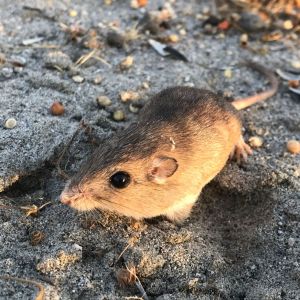LOS ANGELES POCKET MOUSE
Perognathus longimembris brevinasus
Los Angeles pocket mouse is restricted to Southern California and was historically known from San Fernando east through San Bernardino and Riverside, and south through Temecula and Aguanga. It is mostly located in the northern portions of the Upper Santa Ana River planning area. It is scarce due to habitat loss and degradation.
Habitat consists of alluvial deposits of sandy soil in sparsely vegetated areas. Los Angeles pocket mouse feed primarily on seeds, but also is known to eat insects. It has distinctive fur-lined cheek pouches to gather food and stores seeds in underground caches. Breeding activity is between April and June.

| Life Stage/Activity Period | Jan | Feb | Mar | Apr | May | Jun | Jul | Aug | Sep | Oct | Nov | Dec |
|---|---|---|---|---|---|---|---|---|---|---|---|---|
| Hibernation | ||||||||||||
| Peak Surface Activity | ||||||||||||
| Breeding |
See a map of the modeled species habitat distribution
The primary threat to Los Angeles pocket mouse is habitat loss and degradation, and flood control projects that alter the natural cycle of opening the vegetation layer preferred by the mouse. Management includes habitat protection and enhancement, as well as prescribed fire and other tools to remove plant thatch from the landscape.
How you can help: Avoid rodenticides at your home, and try using live-traps or other means to remove unwanted rats and mice.
